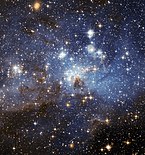Dark nebula
This article needs additional citations for verification. (June 2022) |

| Star formation |
|---|
 |
| Object classes |
| Theoretical concepts |
A dark nebula or absorption nebula is a type of
.Dark clouds appear so because of sub-micrometre-sized dust particles, coated with frozen carbon monoxide and nitrogen, which effectively block the passage of light at visible wavelengths. Also present are molecular hydrogen, atomic helium, C18O (CO with oxygen as the 18O isotope), CS, NH3 (ammonia), H2CO (formaldehyde), c-C3H2 (cyclopropenylidene) and a molecular ion N2H+ (diazenylium), all of which are relatively transparent. These clouds are the spawning grounds of stars and planets, and understanding their development is essential to understanding star formation.[1][2]
The form of such dark clouds is very irregular: they have no clearly defined outer boundaries and sometimes take on convoluted serpentine shapes. The closest and largest dark nebulae are visible to the naked eye, since they are the least obscured by stars in between Earth and the nebula, and because they have the largest
In the inner molecular regions of dark nebulae, important events take place, such as the formation of stars and masers.
Complexes and constellations
Along with molecular clouds, dark nebula make up
Dark nebula form in the night sky apparent

See also
References
- S2CID 119078546.
- ^ ESO - eso9934 - Secrets of a Dark Cloud Archived 2009-02-04 at the Wayback Machine

